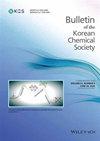Photochemical coupling reaction of phenacyl benzoate with acetone to form 1,4-dicarbonyl compound enabled by charge transfer
IF 2.2
4区 化学
引用次数: 0
Abstract
Photolysis of phenacyl benzoates tethered with a phenol or anisole in acetone resulted in the formation of 1,4-dicarbonyl compounds, coupling products of the phenacyl moiety with acetone. The reaction occurs via electron and/or proton transfer from a triplet exciplex, leading to the formation of a phenacyl radical, which then adds to the enol form of acetone. The reaction also occurs in intermolecular fashion with external electron donors.
苯甲酸苯乙酯与丙酮的光化学偶联反应,通过电荷转移生成 1,4-二羰基化合物
在丙酮中对苯甲酸苯乙酯与苯酚或苯甲醚进行光解,可形成 1,4-二羰基化合物,即苯乙酯分子与丙酮的偶联产物。反应是通过电子和/或质子从三重赋形剂中转移而发生的,从而形成苯羰基自由基,然后与丙酮的烯醇形式相加。该反应也会以分子间方式与外部电子供体发生。
本文章由计算机程序翻译,如有差异,请以英文原文为准。
求助全文
约1分钟内获得全文
求助全文
来源期刊

Bulletin of the Korean Chemical Society
Chemistry-General Chemistry
自引率
23.50%
发文量
182
期刊介绍:
The Bulletin of the Korean Chemical Society is an official research journal of the Korean Chemical Society. It was founded in 1980 and reaches out to the chemical community worldwide. It is strictly peer-reviewed and welcomes Accounts, Communications, Articles, and Notes written in English. The scope of the journal covers all major areas of chemistry: analytical chemistry, electrochemistry, industrial chemistry, inorganic chemistry, life-science chemistry, macromolecular chemistry, organic synthesis, non-synthetic organic chemistry, physical chemistry, and materials chemistry.
 求助内容:
求助内容: 应助结果提醒方式:
应助结果提醒方式:


